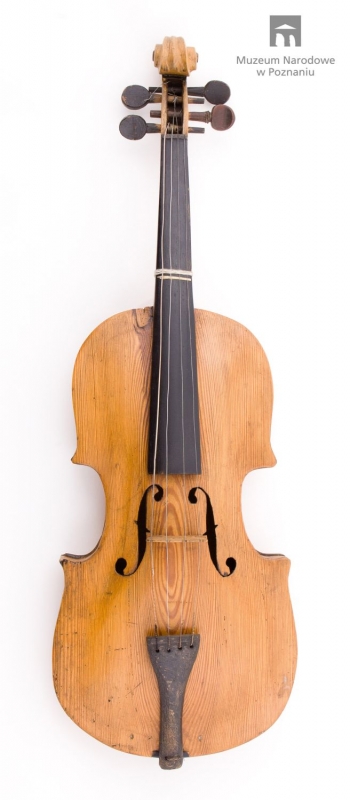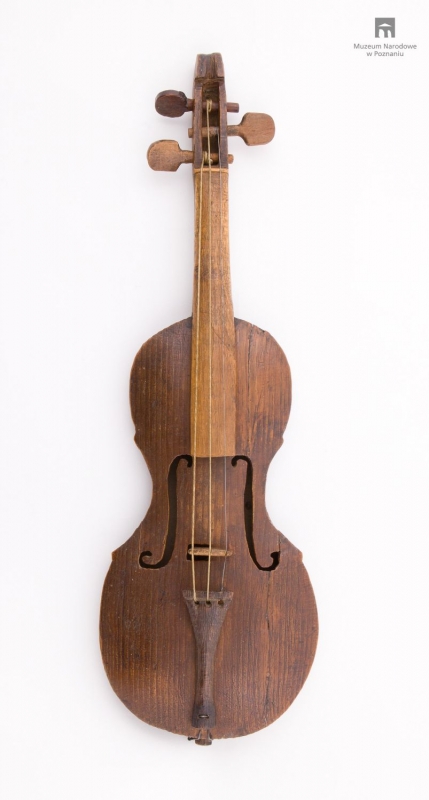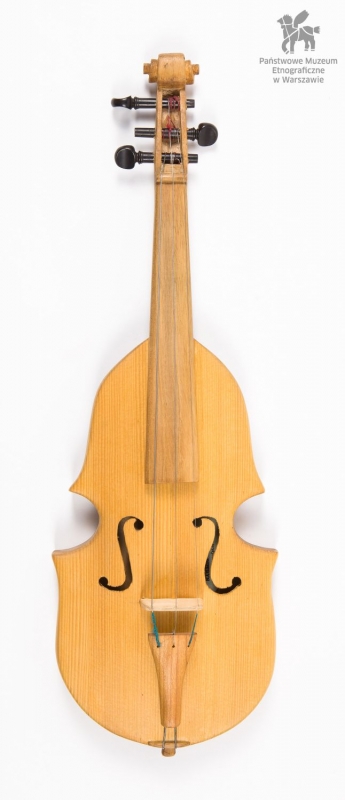Studying folk violin playing to recover early music performance practices
If we look back at the music culture of Poland (and Europe, for that matter), two currents come into sight: written and unwritten music. The first is the work of composers (sometimes anonymous), recorded and passed on to the next generations in the form of musical symbols (or other forms of notation, e.g. tablature). The second is part of oral tradition passed on directly from teacher to student, and called traditional (up to and including the 18th century) or folk (from the 19th century onwards). Both currents coexisted side by side, and still do to some extent, influencing and inspiring each other. As a result, by studying folk music we may recover information on the features of olden instruments and long gone performance practices.
One way to discover how the violin was played in the 16th, 17th or 18th century is to study extant iconography and texts (theoretical treatises). Although they lend little insight into the instrument’s sound or playing technique, they are useful in establishing how the then violins and bows looked like (which we may additionally verified against surviving historical instruments), the way they were held while playing, as well as imparting some basic information on how they were played. It seems that some of these features, especially if we talk about the 16th century when the violin and its playing technique were only maturing, have survived to this day in folk performance practice. Corroborating the hypothesis is the fact that humans’ – and more specifically violinists’ – anatomy and physiology has not changed significantly over that spell of time. The same goes for the context of violin playing. In folk tradition the violin is mainly played to provide dance accompaniment, which conditions repertoire choices and playing technique. As for written music, the violin’s played the role of dance accompaniment instrument in the 16th and to some degree in the 17th century.
In traditional music practice the violin was gaining popularity in the second half of the 17th century, succeeding the bagpipes in the wake of a series of cataclysms that the Polish state faced in the mid-17th century. The Cossack insurrection led by Bohdan Khmelnytsky (1648–1654), plague epidemics (1652–1653), and the Swedish invasion in the course of the Great Northern War (1655–1660) all brought about depopulation, pauperisation (especially in the cities), and economic ruin as a result of which professional bagpipers, who’d been earning a good living before, were losing their jobs and fleeing for other territories, mostly German-speaking countries. With time they were gradually replaced by violinists, who became the leading instrumentalists in folk bands regardless of the region in the 19th century.
Folk music is characteristic for its diversity, both in terms of instruments and performance practice. Made by folk artisans, folk violins differ in their shapes and sizes, construction, and the components and materials they are made of. It could be said that while there was a certain construction model that folk luthiers kept in mind while building their instruments, it would find realisation in many different forms and standardisation was minimal. The same tendency was observed in the past, especially the 16th century. It should also be mentioned that contemporary folk violins in Poland still display some of the construction properties of its predecessors. And not only violins. The same goes for the basy [basses], whose body, neck, pegbox, head and even endpin used to be carved out of a single piece of wood, to which a belly would be later attached. The mazanki of the Polish region of Wielkopolska, the złóbcoki of Podhale, and the oktawka of Beskidy have the same construction. The bridges of the mazanki and olden basses hailing from east Wielkopolska (Kalisz area) and Małopolska (Kielce area) have also retained their archaic form: their feet have different length, with the shorter one resting on the belly and the longer one passing through an opening in the belly’s surface to rest on the inside wall of the back, serving as the sound post. These construction features can be also found in knee-held vielles – instruments associated with the performance of unwritten music and contemporarily reconstructed, for instance the fidel of Płock dating to the mid-16th century and the suka of Biłgoraj known from 19th-century iconography.
The construction of bows was also changing as they were developing over time. Their different forms survived almost to our times in folk violin practice (in some regions more than others), ranging from bows whose hair was permanently fixed to the stick leaving no space for any adjustment of the tension, to ones equipped with a movable frog with a system of notches that worked with knobs on the stick to allow for a stepped adjustment of tension, to bows with a screw similar to the one found in contemporary professional bows. The oldest varieties had convex sticks to make sound articulation more natural.
Similarly to historical violins, olden folk fiddles were fitted with catgut strings. As it was impossible to keep them as tight as the strings in contemporary violins, the sound the instruments produced was not as strong as it is today. However, it was loud enough to accommodate the then needs: in the past both written and unwritten violin music was performed in relatively small spaces, such as inns or court chambers.
In both traditions for a long time there did not exist any standard concerning the tuning of violins. Equal temperament was not common; it was only gradually introduced over the course of the 18th century. In folk music this was manifested by extended ratios of the frequencies between some notes. For instance, the third scale degree (starting from the middle note or tonic in major and minor scales) could be a minor third, a major third, or a neutral third. Similarly, the fourth scale degree could be a perfect or neutral fourth. In the region of Karpaty (Carpathia) this manner of playing has survived to this day, and the less stringent approach to intonation is sometimes referred to as brudzenie [dirtying].
Folk fiddlers, similarly to early violinists, have different ways of holding their instrument when playing: some rest it on their shoulder, others against their neck, chest (on the right or left side) or breastbone. In folk practice, this is contingent on the region as well as the part played by the instrument, For instance in the region of Karpaty (Carpathia) the first violin, called prym [first] is usually propped on the player’s shoulder, while the second violin, called sekund [second] is rested against the player’s chest or breastbone. The reason for this distinction lies in the type of music played: while the first violin performs the melody, the second performs accompaniment. What is more, folk fiddlers often hold their instrument close to their neck, tilting it downwards and sidewards (to the side where the highest strings are), which was also common among 17th-century Italian violinists.
Another element bridging both traditions, see to this day, is the practice of holding the bow above the frog. Despite using longer, standardised, mostly factory-produced violin bows, today’s folk fiddlers hold them above the frog just like violinists in the 18th century did when longer bows were being introduced. Of the two historically used bow grips, the Italian hold has been adopted by classical musicians, while the French hold is most popular in folk performance. (It consists in the player holding the bow with his index, middle and ring finger, while the thumb is inserted under the hair, and the pinkie is raised).
In the 16th century and to some degree up to the end of the 17th century, written violin music was performed in the first position, mostly on the highest string (e’), less often on the lower ones (a’, d’), and never or very rarely on the lowest one (g). The practice is continued in unwritten music to this day. It seems to go back to the time when instruments of the violin type had three strings only, as it is still the case of the mazanki in Wielkopolska and older varieties of złóbcoki in Podhale. Melodies played this way do not have wide range.
Martin Agricola, German theoretician of music and composer, in his treatise Musica instrumentalis deudsch (more specifically its second edition released in 1545), mentions Polische Geigen [Polish violin] and an unusual technique of stopping strings with the use of fingernails. The same technique is nowadays applied to play reconstructed knee-held vielles (fidel of Płock, suka of Biłgoraj).
More conservative folk fiddlers of the older generation, similarly to old-time musicians (especially in the 16th century), rarely used vibrato. If they did it was only to adorn selected sounds. They used clear articulation, usually non legato, indicating the piece’s rhythmic structure.
Another element characteristic for both traditions is drawing on vocal music for repertoire, performance style, and manners of articulation. For a long time, singing was considered the ideal of music, especially that of sacred character. Still at the end of the 18th century Wacław Sierakowski, parson of the Kraków cathedral, wrote: “What the Lord’s Church needs to praise Our Creator, the Heavenly Lord, during Services held in His Shrines is human lungs and nothing more”. Performing vocal-instrumental pieces, violinists would double the vocal line. Interestingly, the repertoire of Polish instrumental folk music is based in a big part on songs: violinists (and other instrumentalists) render song melodies solo or in bands, with or without singers, depending on the region and the type of repertoire.
Early music was based to a large degree on improvisation. Musicians would not always play by the notes as music notation was not commonly used, especially when we talk about unwritten music tradition. Indeed, playing from memory became the basic characteristic of folk music. This is connected with the existence of common motifs, or abstract melodic patterns known to folk musicians through their cultural competence. A motif practically manifests itself only through countless variants and renditions. Thus, improvisation and creative interpretation are a specific feature of traditional music performance in general and traditional violin performance in particular. This manner of playing was adapted both by solo musicians and bands, where each of the members would realise the melodic line in their own way, a practice termed variational heterophony.
Both written and unwritten music employed tempo rubato, yet it was realised differently in each performance practice. In the unwritten tradition rubato survived to this day, although usually only in some regions – mainly in Mazowsze and north Małopolska (Radom area), where it is realised within a bar, and in Podhale, where it spans a phrase.
Most probably, in the 16th century different manners of playing the violin were known. This is still the case in contemporary folk music, and depends on the tradition of the region, subregion, or a player’s individual preferences. Sixteenth-century musicians played mostly to provide accompaniment for dance. Also in folk culture, accompanying dance is the basic, in many cases the only, role taken up by musicians, including violinists. A Polish folk saying states that a good accompanist helps the feet move and a bad one will make you stumble. Thus, good accompaniment facilitates dancing by indicating the right meter, rhythm and accents, while a bad one – for the lack of these qualities – will hamper a dancer’s performance. It should be stressed here that providing good accompaniment for dance is a distinct ability, independent of the violinist’s general skill and technical proficiency.
Professor Zbigniew J. Przerembski
Bibliography:
1. David D. Boyden, Dzieje gry skrzypcowej od początków do roku 1761 oraz jej związek ze skrzypcami i muzyką skrzypcową, (Kraków 1980).
2. Ewa Dahlig, Ludowa gra skrzypcowa w Kieleckiem, (Kraków 1991).
3. Ewa Dahlig, Ludowe instrumenty skrzypcowe w Polsce, (Warszawa 2001).
4. Ewa Dahlig-Turek, Maria Pomianowska, Polskie fidele kolanowe: (re)konstrukcja, (Warszawa – Lublin – Kraków 2014).
5. Zbigniew J. Przerembski, Dudy: dzieje instrumentu w kulturze staropolskiej, (Warszawa 2006).







